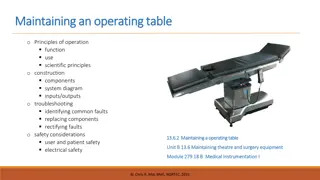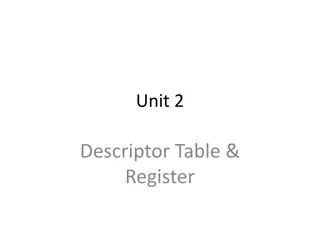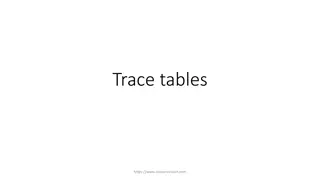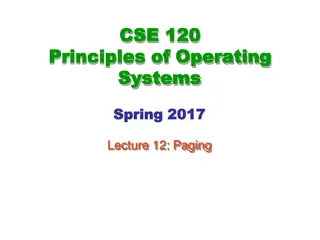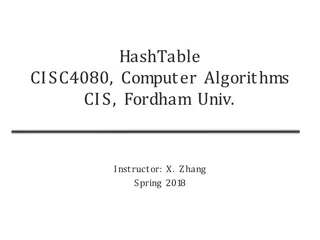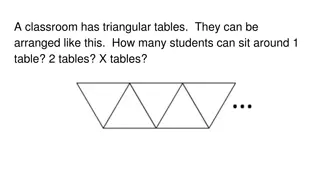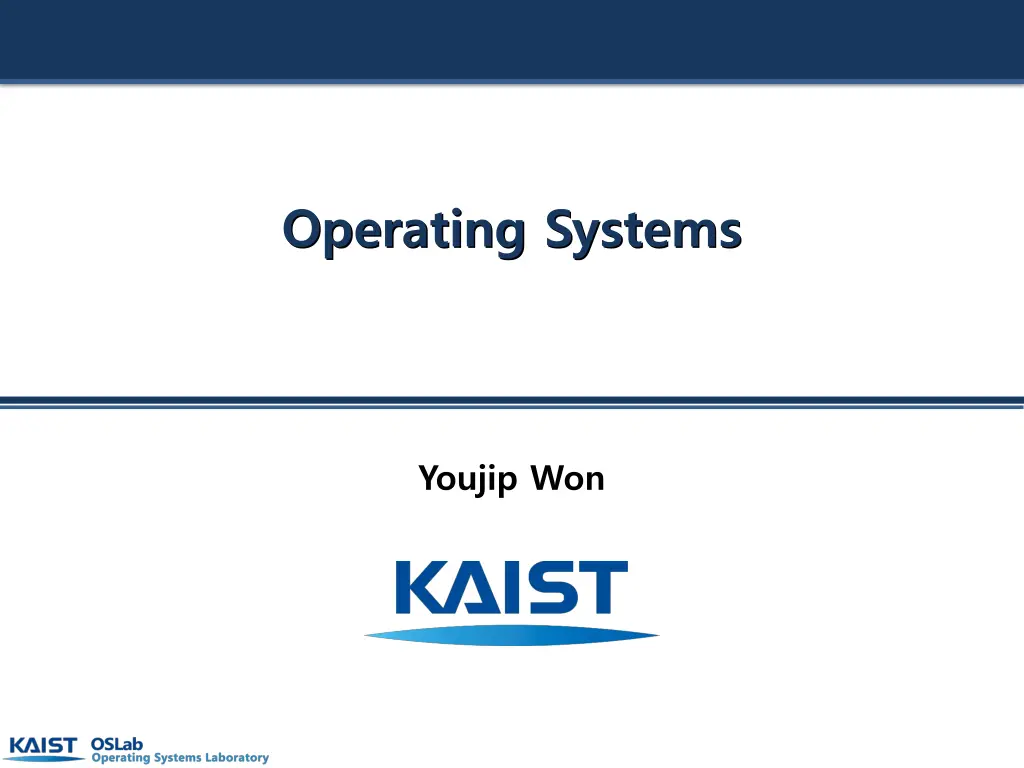
Advanced Operating System Concepts by Youjip Won
Explore advanced concepts in operating systems such as linear page tables, problems in page table management, hybrid approach combining paging and segments, and multi-level page tables. Dive deep into memory management strategies and the challenges they present in modern computing environments.
Download Presentation

Please find below an Image/Link to download the presentation.
The content on the website is provided AS IS for your information and personal use only. It may not be sold, licensed, or shared on other websites without obtaining consent from the author. If you encounter any issues during the download, it is possible that the publisher has removed the file from their server.
You are allowed to download the files provided on this website for personal or commercial use, subject to the condition that they are used lawfully. All files are the property of their respective owners.
The content on the website is provided AS IS for your information and personal use only. It may not be sold, licensed, or shared on other websites without obtaining consent from the author.
E N D
Presentation Transcript
Operating Systems Youjip Won
20. Advanced Page Tables 2 Youjip Won
Linear Page Table One page table for every process in the system. 32-bit address space with 4KB pages and 4-byte page-table entry. 2^20 page table entries in the page table. 4B entry entry entry 4KB Page 0 Page 1 Page 2 Page n entry Physical Memory Page Table of Process A ??? ??? ????? = ?????? Page table size = Page table is too big and thus consumes too much memory. 3 Youjip Won
Problem in Linear Page Table Most of the page table is unused, full of invalid entries. Physical Memory Virtual Address Space 0 1 2 3 4 5 6 7 8 9 10 11 12 13 14 15 16 17 18 19 20 21 22 23 24 25 PFN 9 - - - 15 - 3 23 valid 1 0 0 0 1 0 1 1 prot r-x - - - rw- - rw- rw- present 1 - - - 1 - 1 1 dirty 0 - - - 1 - 1 1 code 0 0 Allocate 1 1 2 2 3 3 4 4 heap 5 5 6 6 7 7 8 8 9 9 10 10 11 11 12 12 A Page Table For 16KB Address Space 13 13 stack 14 14 15 15 A 16KB Address Space with 1KB Pages 4 Youjip Won
Hybrid Approach: Paging and Segments Page table for each segment the base register for each of these segments contains the physical address of a linear page table for that segment. The bound register: indicate the end of the page table. Example: Each process has three page tables associated with it. 31 30 29 28 27 26 25 24 23 22 21 20 19 18 17 16 15 14 13 12 11 10 9 8 7 6 5 4 3 2 1 0 Offset Seg VPN 32-bit Virtual address space with 4KB pages Seg value 00 01 10 11 Content unused segment code heap stack 5 Youjip Won
Translation on Hybrid Approach The hardware gets physical address from page table. The hardware uses the segment bits(SN) to determine which base and bounds pair to use. The hardware then takes the physical address therein and combines it with the VPN as follows to form the address of the page table entry(PTE) . 01: SN = (VirtualAddress & SEG_MASK) >> SN_SHIFT 02: VPN = (VirtualAddress & VPN_MASK) >> VPN_SHIFT 03: AddressOfPTE = Base[SN] + (VPN * sizeof(PTE)) 6 Youjip Won
Problem of Hybrid Approach Hybrid Approach is not without problems. If we have a large but sparsely-used heap, we can still end up with a lot of page table waste. Causing external fragmentation to arise again. 7 Youjip Won
Multi-level Page Table Turn the linear page table into something like a tree. Chop up the page table into page-sized units. If an entire page of page-table entries is invalid, don t allocate that page of the page table at all. To track whether a page of the page table is valid, use a new structure, called page directory. 8 Youjip Won
Multi-level Page Table Linear Page Table Multi-level Page Table PBTR 201 PBTR 200 valid prot 1 1 0 1 0 0 0 0 0 0 0 0 0 rx rx - rw - - - - - - - - - 12 valid valid PFN201 PFN 13 prot PFN PFN - 1 0 0 1 201 - - 203 1 1 0 1 rx rx - rw 12 13 - 100 100 - - - - - - - - - PFN200 PFN201 PFN202 The Page Directory [Page 1 of PT:Not Allocated] PFN203 [Page 2 of PT: Not Allocated] 0 0 1 1 - - - - PFN204 rw rw 86 15 PFN204 0 - - 1 rw 86 1 rw 15 9 Youjip Won
Multi-level Page Table Page Directory one entry (page directory entry) per each page of the page table. PDE has a valid bit and page frame number(PFN). Advantage Only allocates page-table space in proportion to the amount of address space you are using. Disadvantage For translation, multiple memory accesses. 10 Youjip Won
Example: Virtual Address Layout code code (free) (free) heap heap (free) (free) stack stack 0000 0000 0000 0001 ... Page 0,1: code Page 4,5: heap Page 254, 255: stack 0000 0100 0000 0101 .. 1111 1110 1111 1111 11 Youjip Won
Example: Single Level Paging Flag Detail Process Virtual Address Size 16 KB (2^14 Byte) Page size 64 byte (6 bit for page offset) --> 2^8, 256 page frames Virtual address representation 14 bit ( 8bit VPN + 6 bit page offset) Page table entry 4 Byte A 16-KB Address Space With 64-byte Pages 13 12 11 10 9 8 7 6 5 4 3 2 1 0 Offset VPN Single level paging 256 page table entries: 2^8 entries Page table size: 256 * 4 Byte = 1 Kbyte Page table consists of sixteen pages (64 byte each): 1024/64 = 16 12 Youjip Won
Example: Single Level Paging PFN: 10 PFN: 23 code code (free) (free) heap heap (free) (free) stack stack 0000 0000 0000 0001 ... Page 0 16 entries PFN: 80 PFN: 59 0000 0100 0000 0101 .. Page 1 2^8 entries 1111 1110 1111 1111 . . . Page 0,1: code Page 4,5: heap Page 15 Page 254, 255: stack PFN: 55 PFN: 45 13 Youjip Won
Example: two level paging Page directory A page table consists of 16 pages We need 16 entries for page directory. 16* 4 byte = 64 byte is required for page directory. it can fit in a page. 4 bits for page directory index. PDEAddr = PageDirBase + (PDIndex * sizeof(PDE)) Page Directory Index 13 12 11 10 9 8 7 6 5 4 3 2 1 0 Offset VPN If the page-directory entry is invalid, raise an exception (The access is invalid). 14 Youjip Won
Example: two level paging Page Table pages 16 entries Page 0 Page page directory 16 entries Page 1 16 entries 16 entries Page 2 16 entries Page 15 15 Youjip Won
Examples PFN: 10 PFN: 23 code PFN: 80 PFN: 59 heap Single level paging: 16 pages Two level paging: 3 pages PFN: 55 PFN: 45 stack 16 Youjip Won
More than Two Levels In some cases, a deeper tree is required. Consider the following address space. 29 28 27 26 25 24 23 22 21 20 19 18 17 16 15 14 13 12 11 10 9 8 7 6 5 4 3 2 1 0 offset VPN Flag Virtual address Page size VPN Offset Detail 30 bit 512 byte 21 bit 9 bit 17 Youjip Won
More than Two Level : Page Table Index Number of pages in a page table 2^21 page table entries 2^7 (128) PTE s in a single page (512/4, 512 page size, 4 byte pte size) 2^14 pages in a page table Number of page directory entries: 2^14 29 28 27 26 25 24 23 22 21 20 19 18 17 16 15 14 13 12 11 10 9 8 7 6 5 4 3 2 1 0 Page Directory Index Page Table Index VPN offset Flag Virtual address Page size VPN Offset Page entry per page Detail 30 bit 512 byte 21 bit 9 bit 128 PTEs (512/4) 18 Youjip Won
Single level page table PFN: 10 PFN: 23 PFN: 80 PFN: 59 2^21 PFN: 55 PFN: 45 19 Youjip Won
two level page table Page directory Page table page 0th 2^7 2^14 (2^14-1)th 2^7 20 Youjip Won
More than Two Level : Page Directory The number of pages in a page directory: 2^14/2^7 = 2^7 (128) Page the page directory 30 29 28 27 26 25 24 23 22 21 20 19 18 17 16 15 14 13 12 11 10 9 8 7 6 5 4 3 2 1 0 Page Table Index PD Index 1 PD Index 0 VPN offset 21 Youjip Won
three level page table Page table page Page table page 2^7 2^7 Page directory 2^7 2^7 Page table page 2^7 2^7 22 Youjip Won
Inverted Page Tables Keeping a single page table that has an entry for each physical page of the system. The entry tells us which process is using this page, and which virtual page of that process maps to this physical page. 23 Youjip Won
Summary Reducing the page table size Per segment page table Multi-level paging Efficient use of memory Severe TLB miss 24 Youjip Won



